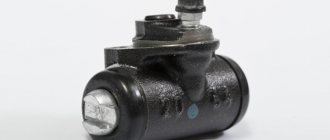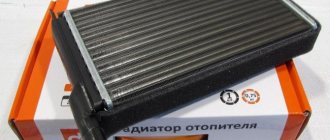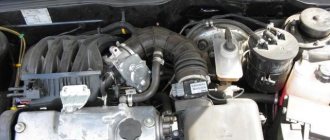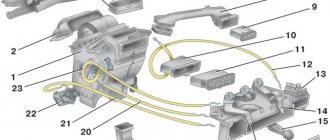The thermostat is an important element in the cooling system. It regulates the movement of fluid, ensuring the engine warms up when starting, and cools after warming up.
The effect of a working thermostat remains invisible. It does not require periodic maintenance. When it stops working, the motor quickly overheats and even boils. Then you need to look for the cause and change the thermostat, if that is the reason.
The thermostat cannot be repaired, it must be replaced. Every car enthusiast can handle this type of repair on his own. It looks the same for 2114 and 2115, so this article will be useful for owners of both models.
How to check the thermostat
It is very easy to check the operation of the thermostat without removing it from the car. It is enough to start the cooled engine and check the temperature of the radiator pipes. In normal mode, when the engine is running, for some time after starting, only the upper radiator pipe will heat up slightly, and when the threshold value is reached, the lower pipe will also heat up sharply. This is evidence of normal valve operation. If heating of both radiator pipes begins simultaneously, this indicates that it is not functioning properly; most likely, the valve is constantly open.
The constantly open thermostat valve allows you to easily reach the nearest service station or spare parts store. It is much worse if the thermostat gets stuck closed, as there is a serious risk of engine overheating. Sometimes tapping on the thermostat body helps for a short time, but if the valve cannot budge, it should be removed or bent with a screwdriver. The thermostat must be replaced in the nearest locality.
Ways to check an element
You can check the operation of the thermostat yourself directly in the car. In the vast majority of cases, such diagnostics give reliable results. You need to start checking when the engine has completely cooled down: start it and periodically feel the lower part of the radiator and the pipe extending from the bottom back to the engine.
The serviceability of the thermostat is determined by the following signs:
- at the initial stage of warming up, the radiator and the pipes suitable for it are completely cold;
- at an antifreeze temperature of 40–60 °C, the upper supply hose begins to warm up, the lower one remains cold;
- when the antifreeze heats up to 90–95 °C, the entire area of the heat exchanger and the lower pipe become hot, which indicates the opening of the damper and the movement of liquid along a large circuit.
It is recommended to carry out diagnostics until the sensor is triggered and the fan automatically turns on.
Deviations from the norm are interpreted as follows:
- If the inlet and outlet pipes together with the radiator immediately warm up, the thermostat is stuck in the open position. Antifreeze initially flows in a large circle, hence the heating.
- When the temperature reaches 90 °C, the bottom of the heat exchanger and the outgoing hose remain cold - the thermoelement damper is tightly closed, the part has become unusable.
- When the top of the radiator is hot and the bottom is slightly warm, the thermostat is stuck half-closed.
Unlike the first two points, the last conclusion requires mandatory confirmation. It is quite difficult to make a clear diagnosis when the coolant is divided into two streams moving along different circuits. Uneven heating of the heat exchanger fins, turning on of the fan and temperature surges are indirect signs. Symptoms of an air lock in the cooling system appear similarly.
To clearly check the functionality of the thermostat, it will have to be removed from the car. Disassembly and diagnostics are performed in the following order:
- Let the engine cool and drain the antifreeze - first from the cylinder block, then from the radiator. It is more convenient to empty the system into a wide container with low sides.
- Loosen the clamps securing the pipes to the thermostat. Disable them and remove the element.
- Inspect the part for a slightly open damper. If a malfunction is detected, further checking is pointless - you need to buy and install a new spare part.
- Heat a pan of water on the stove. When its temperature approaches boiling, lower the thermostat into the container and watch the damper. It should open without delay.
- Remove the part from the pan. When cooled, the thermoelement should immediately close the passage.
Reminder. After draining the cooling system, immediately disconnect the throttle body heating pipe. When you start pouring antifreeze back in, air will escape through the removed hose.
If during the inspection it turns out that the damper does not work or is jammed, the part must be replaced, since it cannot be repaired. Considering the large number of fakes on the auto parts market, you can first test a new thermostat in a store. Close the outlet pipe with your finger and try to blow air through the inlet pipe. A hermetically sealed damper will prevent this from happening.
Retest the new part at home by immersing it in a pan of boiling water. If the heat-sensitive mechanism does not work, return the defective part to the store or exchange it for another one.
Where is
It is located under the air filter housing on injection cars, but on carburetor Samara 2 (namely, the first VAZ 2115 were produced for a couple of years in a carburetor version), it is located exactly there, but the housing on them has simply been moved to a slightly different place, so it is no longer necessary on the carburetor It doesn’t take much trouble to remove the housing, but I just threw off the high-voltage wires and started working, but it doesn’t take long to remove the housing and on the injector it 100% needs to be removed to get to the thermostat, and after the housing is put aside, you will immediately see the thermostat is not armed it will even be visible to the eye (For clarity, it is indicated in the photo below with a red arrow) and next to it there is also a battery (indicated by a blue arrow) so that you understand 100% where it is and do not lose sight of it.
Replacement or repair
Of course, it is possible to repair a broken device, but is it really that effective? If you consider the repair option, it is recommended that it be carried out exclusively in the field if you have the necessary tools. If the valve is not working, you can try to clean it in order to get to your destination. After this, it is recommended to immediately replace it.
The thermostat on the VAZ 2114 is a consumable item, the cost of which is not so high to try to repair it. Purchasing a new device guarantees its long service life, while a refurbished device may break down after just a few days. Therefore, in the event of a breakdown, it is recommended to install an analogue, even within 500 rubles, which can definitely last at least six months to a year.
The principle of operation of the VAZ 2115 thermostat
In a car's engine cooling system, a thermostat automatically opens and closes a large cooling circuit for antifreeze.
Let's try to explain this in a nutshell. The engine cooling system consists of a small and a large circuit.
In the engine warm-up mode, the antifreeze is driven by the system pump only through the engine cooling jacket and the heater. This allows you to quickly heat the cylinder block to operating temperature. But further on we can’t do without additional cooling.
When a certain temperature is reached, the thermostat opens a channel into a large circuit - the coolant enters the main radiator, equipped with an additional highly efficient electric fan operating at several speeds. By opening and closing the valve, the thermostat not only maintains the set antifreeze temperature, but also ensures the energy efficiency of the power plant.
Using the VAZ 2115 car as an example, I will now show how it works:
- When the car is not warmed up, the thermostat valve is closed, as in the photo. In this case, the coolant moves in a small circle, as in the photo below.
- When the machine warms up to operating temperature (87-90 degrees), the temperature-sensitive element slowly begins to heat up, as a result of which the spring compresses, the main valve opens and the liquid flows in a large circle.
Design Features
A thermostat is a small mechanical valve. The device regulates and determines the temperature of the coolant in the engine system and is responsible for the quality of warming up the car engine. The structure consists of the following elements:
- frame;
- inlet pipe. Connects directly to the cooling system;
- wax ball;
- main valve Responsible for blocking the main circulation process;
- piston;
The thermostat regulates the temperature of the coolant in the engine
- bypass valve. If necessary, closes the small cooling circle;
- special spring to hold the portable valve;
- outlet pipe. Connects to a pump pumping cooled liquid;
- a spring holding the bypass valve;
- additional inlet pipe. The element is connected to the radiator.
This video will help you get acquainted with the principle of operation of the thermostat:
Types of modern thermostats
Today, car manufacturers equip engines with different thermostats. There are several main types of these useful structures:
- Electronically controlled device. Suitable for all operating modes of the power unit. Electronic devices are supplemented with a special heating resistance. Known for their efficiency and accuracy. Their use allows to reduce fuel consumption.
- Single valve. Reliable and durable unit. The majority of cars are equipped with a single-valve thermostat.
There are several main types of
two-valve automobile thermostats. One thermostat has two valves: the main and the secondary. The main one is used to circulate antifreeze in a large circle. The second, the so-called bypass valve, performs similar actions, only in a smaller circle. Two-valve thermostats are in demand in the CIS.
Two-stage. The design also provides two valves: large and small. It is recommended to install in a system with high coolant pressure.
It will be useful: How to remove a brake drum on a Renault Logan
Signs and causes of failure
Any malfunctions in the operation of the device have a detrimental effect on the operation of the entire vehicle. The main symptom and cause of the malfunction is considered to be corrosion. It gradually corrodes the locking pin and cylinder. A sign of a broken thermostat in this case is a pulsating, continuous flow of cooled liquid.
It does not matter what position the valve is in. Signs of a faulty thermostat also include:
- The lower pipe becomes warm within a few minutes of operation of the unit. The device is always open.
- The car engine quickly overheats. When a car engine overheats, the design pipes (lower and upper) are at the same temperature.
A faulty thermostat is indicated by engine overheating and several other indicators.
While the device is operating, the engine needle drops sharply and shows a temperature lower than normal. When the engine stops running, the needle reading increases. Staying in a closed position for a long time. In this case, the structure literally jams. The temperature on the instrument panel shows that it is boiling. After prolonged operation of the engine, the lower pipe remains cold.
Due to breakdowns, the car cannot start normally. You should understand why the thermostat is not working and find out the signs of unit failure as soon as possible. Violation of the temperature regime has a detrimental effect on the engine: it quickly wears out and becomes unusable.
How to check the thermostat on a VAZ 2115 - two ways
In order to check the thermostat on a VAZ 2115, you must perform the following steps:
- Take a pan with cold water, a thermometer up to at least one hundred degrees and a thermostat.
- We put it all on the tile to warm up and wait... We wait until the water temperature reaches 85 degrees.
- At this point we begin to look at the main thermostat valve. At 87 degrees it should open.
- If it does not open or opened earlier, then the thermostat is faulty.
There is another way to check the thermostat without removing it from the car. But for this, the car must be cold:
- After starting the engine, grab the lower pipe coming from the radiator with your hands.
- Until the temperature reaches 80 degrees it should be completely cold. When it reaches 85 degrees, the tube should begin to warm up slowly.
- And when 90 degrees is reached, full circulation of hot coolant should begin (i.e. the valve is completely open). The lower tube should be hot.
It happens that immediately after starting the engine, when it has warmed up only 50 degrees, warm liquid begins to flow through the lower tube. This shouldn't happen either!!! This means that the valve is constantly open.
Which thermostat to install
Original number 21082-1306010.
- Luzar LT 010892 — 519 rub.
- Master-sport 21082-S-PCS-MS — 706 rub.
- Kraft KT 019510 — 713 rub.
Before removing the thermostat, you need to drain the coolant, so first we find the drain valve at the bottom of the radiator and place a container under it.
To allow fluid to drain out of the radiator faster, open the cap of the expansion tank.
Sweat antifreeze or antifreeze drains..
you need to clear access to the thermostat. And to do this you will have to unscrew the bolts, remove the clamp and the chip from the mass air flow sensor in order to move the air filter box to the side.
To remove the thermostat on a VAZ 2114 or 2115 with a 1.6 liter engine, you need to remove two clamps and unscrew the three fastening bolts with a hexagon (on a 1.5 liter engine, a key is not required).
By unscrewing the bolts and pulling off the pipes, you can remove the thermostat.
We install the new thermostat in the reverse order, only before installing it we clean the seat, install a gasket or coat it with a thin layer of sealant.
We put all the pipes back.
Before pouring coolant into the expansion tank, remove the pipe that is located on the heating of the throttle assembly (needed to expel the air lock).
Fill the expansion barrel with new coolant (the level should be slightly higher than the mark on the barrel).
In the indicated places we will press the pipes with our hands in order to expel the air from the system.
Placing a container under the hose from the throttle heating, close the tube with one hand and press the pipes with the other. Coolant and air will splash from the hose. We do this several times...
Car thermostat: how to check, typical faults, symptoms
The thermostat is a small but important element of the car, which allows the driver to save on engine maintenance and fuel. Essentially, the thermostat is a temperature regulator in the cooling system. Due to it, the engine warm-up speed increases, and the car maintains the desired thermal conditions during operation.
The main task facing the thermostat in a car is to prevent the circulation of coolant through a large cooling circle until the engine warms up after starting.
After starting the engine, the antifreeze begins to circulate in a small circle until it reaches an operating temperature of approximately 90 degrees Celsius. Having warmed up, the coolant enters a large circulation circle and circulates through it until it cools down again (due to various reasons).
Through its actions, the thermostat maintains the operating temperature in the engine, preventing it from overheating or excessively cooling.
Repair and replacement
If the thermostat is clogged, you can try to wash or clean it. This limits the possibilities for repairing a faulty thermostat. In some cases, in the summer you can drive without a thermostat at all. Often, this is done when the radiator of the cooling system is quite clogged. But, this solution only works in the summer.
The thermostat on a car is not a universal device, and therefore, to replace it, you need to select a product that is suitable specifically for a specific car model.
And of course, you shouldn’t neglect thermostat breakdowns. Especially when it remains closed when access to a large cooling circle needs to be opened.
Both rapid engine overheating and a long period of reaching operating temperature can have the same cause - a malfunctioning thermostat. This small but very important device is responsible for regulating the circulation of coolant in the cooling system. Its function is to ensure quick warm-up of a cold engine, as well as to prevent overheating of the engine operating in optimal mode.
In order to make sure that malfunctions in the cooling system are due to a malfunction of the thermostat, there are several ways to check its performance. Typically, the thermostat is located in the space between the engine and the radiator, and therefore, when using methods for checking it directly at the installation site, you should be careful not to get burned on hot elements. Methods for checking the operation of a thermostat are based on the principle of its operation. They consist in the fact that the device opens and closes the pipeline valve, ensuring the circulation of coolant either in a large circle (that is, through the radiator) or in a small one.
The first method is to let the engine run for 2-3 minutes and then carefully feel with your hand the hose that goes from the thermostat to the radiator. If the hose is cold, then everything is fine.
If it is warm, it means the valve is not closed tightly and the engine will take a long time to heat up to operating temperature. This circumstance leads to excessive fuel consumption. Next, you should let the engine warm up to operating temperature, that is, 85-90 degrees. After this, again feel the pipe connecting the thermostat to the radiator. It should be hot. If it stays cold, the thermostat is stuck closed. In this case, the engine may overheat, since the coolant is not able to circulate through the large circuit. The second method is similar to the first, but simpler. You need to start the car and let the engine warm up to operating temperature. After this, you need to carefully feel the upper hose leading to the radiator and the lower hose leading from the radiator. If the top hose is hot and the bottom hose is cold, then the thermostat is faulty because it is not circulating coolant through the large circuit. The next method is to check the thermostat at home. Before checking the thermostat using this method, allow the engine to cool and drain the coolant. The thermostat is removed, placed in any suitable container and filled with water. The water is heated on the stove until it boils. The malfunction is determined visually. If the valve has opened, then the thermostat is working; if not, it’s time to change it. The fact is that artificial wax is placed inside the cylinder in the thermostat, which begins to melt at a temperature of 82°C. As the wax expands, it pushes out the pin, which opens the valve. When the wax cools, the pin slides back.
Features of the VAZ-2115 thermostat and its operating principle
The thermostat is an essential element in a vehicle's cooling system. A new domestically produced part can withstand from 80,000 kilometers to 100,000 kilometers, and an imported one - about 120,000 kilometers. It is very important that the thermostat is of high quality, so it is necessary to purchase it for replacement in specialized auto stores.
A car thermostat controls the temperature of the coolant (for example, antifreeze), and distributes it among circulation circles - small and large. If the vehicle engine and cooling fluid are cold, the thermostat valve will be closed, allowing the small circulation circle to operate.
As soon as the optimal temperature regime of the cooling liquid is reached, the thermostatic valve will operate, that is, it will open and a large circulation circle will come into effect.
The flow of coolant will enter the radiator, and the temperature will stop increasing, and its level will stabilize - optimally 90 degrees. This is the principle of operation of the thermostat element in good condition.
When to change: signs of thermal switch failure
Abstract symptoms can indicate the nature of the disease that has befallen the thermostat:
Stuck in open position (coolant constantly circulates through radiator)
In cold weather, the engine does not heat up well, and at extreme city speeds the coolant temperature drops. Let's say it's -15°C outside, the coolant at idle has warmed up to 70°C, we're driving on a multi-lane road, moving at a speed of 60 km/h, and the temperature gauge needle is either standing still or going down. Fuel consumption increases noticeably (+ 1-2 liters per 100 km)
The wedge is in the closed position (antifreeze moves along the jacket and heater radiator, bypassing the main heat exchanger). There will be no cooling and overheating is inevitable in summer. The fact is clearly clarified by the thermometer needle running upward when the cooling fan is on. Additionally, the “brains” indicate a problem in the form of an illuminated Check Engine icon. Final stop at an intermediate position. Prolonged heating + overheating in hot weather. Slight increase in appetite (within 1 l/100 km)
Fuel consumption increases noticeably (+ 1-2 liters per 100 km). The wedge is in the closed position (antifreeze moves along the jacket and heater radiator, bypassing the main heat exchanger). There will be no cooling and overheating is inevitable in summer. The fact is clearly clarified by the thermometer needle running upward when the cooling fan is on. Additionally, the “brains” indicate a problem in the form of an illuminated Check Engine icon. Final stop at an intermediate position. Prolonged heating + overheating in hot weather. Slight increase in appetite (within 1 l/100 km).
It is impossible to close a large circle tightly, while the rod moves and the full opening occurs. There is no wedge. This is prevented by deposits accumulated as a result of untimely change of antifreeze, mixing coolant of different classes (for example, on a Hyundai Solaris, antifreeze can only be mixed with G11), and the use of cheap or counterfeit fluids. The fact can be revealed in warm weather only through tubes. In winter, pollution will be indicated by a reluctant rise in temperature from 70°C to 90-95°C when driving on the highway, but in the city there will be no problems with warming up. Seeing such a picture, those who like to cover the radiator grille with cardboard often persuade the owner to insulate the front end. This is definitely useful in cold weather.
When does a thermostat need to be replaced?
For proper operation of a vehicle, it is important that the temperature of its engine is within the same limits. This can be achieved through the use of coolant - antifreeze or antifreeze - and the proper operation of the entire cooling system of the car. As soon as the temperature begins to exceed the required limits (most often it is 90 degrees), you should check the car thermostat for serviceability. If it turns out that this part is out of order, then there will be a need to replace it with a new one.
Operating principle
The operating principle of the KAMAZ thermostat is also no different. The difference is the engine cooling principle. The system works as follows:
- Cold coolant, after the engine starts, circulates through the channels of the power unit, pumped into the system by a water pump.
- At this time, both valves are closed by large bowls, only small bowls are open. The valve is designed so that the small bowls have a factory seat clearance.
- Initially, the left cylinder block is heated, and after it the antifreeze flows to the right side.
- After the antifreeze temperature has reached a threshold of 80 degrees, the small bowls close. Large bowls are opened. This occurs due to the heating and melting of the mixture of wax and aluminum in the thermoelement bulb. Due to melting, the pressure on the rods increases, they open, closing the passage channels with small locking bowls.
- The liquid opens the way to the radiator for cooling and temperature stabilization.
This process is repeated as the load on the engine increases, when operating modes and engine speed change.
This system allows you to quickly and evenly warm up both cylinder blocks of the power unit.
Modern KamAZ EURO-4 vehicles are equipped with more advanced thermostats. They received an addition in the form of an electrical thermistor. The on-board computer regulates the temperature and timing of valve opening by heating this element. This is necessary to quickly cool the liquid when heavy loads are placed on the engine.
These cars also received fans for additional cooling. During operation, the engine temperature can cross the threshold of 97 degrees. To cool such a volume of antifreeze, manufacturers equipped an electric fan with a temperature sensor. It automatically operates to activate an additional cooling mechanism.
Checking a new thermostat before installation
Before replacing the VAZ-2114 thermostat, you need to check the functionality of the new one. The check is performed in the following order:
- Fill the container with water and place the device in it.
- Place the dish with the appliance on the stove and heat it, controlling the heating temperature.
We heat the water with the device, controlling the temperature
- When the temperature rises to 85˚C, the valve will open.











